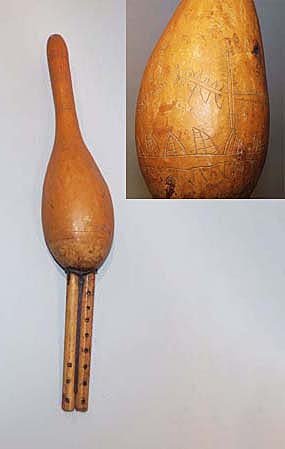
Owner: HWMC
Catalogue #: 2AS-AEBH-01-16
Reedpipes
India ‘Pungi’ (Bin) - A
Northern India
Rajasthans
Bamboo, gourd, wax, resin
Total Length: 16 in; Width: 4.5 in; Depth: 4.75 in
Mid 20th century
Aerophones – Wind Instruments Proper – Reedpipes
The pungi is an important instrument in Indian folk culture and is known by various names in different parts of India. Sometimes considered a double clarinet, it consists of two small cane (or bone) pipes, one a melody pipe with various finger holes and one a drone pipe that may or may not have holes. The tops of these pipes are affixed into a bottle gourd (tumbda) with wax and resin. Depending upon the region, and how musically developed they are in various areas, some have a wooden wind cap to blow into. The performers use a technique called circular breathing (naksasi) consisting of breathing air in through the nose while simultaneously blowing out through the mouth.
This pungi with a larger bottle gourd (dudhia) that extends into a mouthpiece is often called both a pungi or bin (been). It is found and played by Rasjasthan cobra charmers and for the Rajasthan Kalbeliya dances in the northwest regions of South Asia. When used as a cobra charmer, a long stick or pole is attached parallel to the two windpipes. The snake has no external ears to hear the music, however, they do have ear bones in their heads, so they mainly follow the movement of the pole when the pungi is played by the cobra charmer.
There is low incised geometric carving throughout on this pungi, but it is not clearly visible in the photo. The instrument was often used to entertain the public with snake charming. However, this practice was eventually banned throughout the country in 1991, under the Wildlife Protection Act, 1972. Nevertheless, it still plays an important roll in accompanying the Rajasthan Kalbeliya dances.
